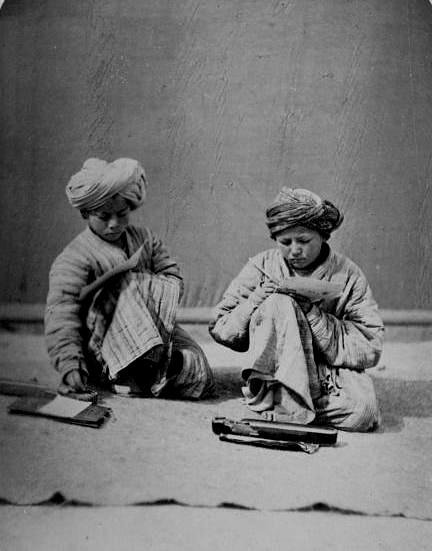
Turkmenistan Education

Figure 1.-- This photograph came from a collection of Central Asian ethnographic studies--'Turkestanskii al'bom, chast' etnograficheskaia, 1871-1872'-part 2, vol. 1, p. 67. The title was 'Musul'manskaia shkola Uroki chistopisaniia', Muslim school hand-writing lessons. Children learned handwriting by copying out Koranic verses.
|
|
Turkmenistan is the southern-most of the former Soviet 'stans' or Soviet central Asian republics. We havebeen able to find very little information about education in the pre-Soviet era. Education was very limited. Ilitracu\y was almost universal among women and very high among men. Those Turkmens that were literated were educated in traditional Muslim schools, mostly in Bukhara and Khiva. The schools were associated with mosques. There was no state schools or secular education of any time. The curriculum was mostly built around the Koran and other Islamic texts. Mesorization of Koranic verses was a major part of instruction. This situation was prevalent throughout Central Asia. This is one reason why life in Central Asia ws basically unchanged fir centuries. The Tsarist Empire conquered the area (late-18th century). They did not, however, introduce Western secular education. One source reports a few of New Method schools set up by Muslim reformers (Jadids) in Kerki, Chardzhou (now Chärjew), and other towns. Even after the collapse of the khanates during the Russian Civil War (1920), traditional Islamic education continued. Soviet authorities began to close the traditional Islamic schools with new secular schools (1928). This was one aspect of Stalin's atheism campaihn. Only with the new Soviert schools did literacy rate begin to increase abd fir thefirst time girls were educated in large numbers.
New schools staffed by many Russians brought secular education to Turkmen, albeit with aheavy load of ideology. As a result, when the Soviet Union was disolved and Turmenistan became independent, literacy was essentially universal.
Educational levels werehigh by Asian standards. The education system has declined since independence. Educational achievement has declined affecting the skill level of the working population. Educaion authorities has limited curricula, cutting out many subjects demmed 'dangerous' or useless. Funding has been aproblem, especially meeting the needs of a growing population. Teacher salaries have been lowered and maintenance of school facilities has been poor resulting in deterioraying infrastructure. A major problem has been the firing of many ethnic Russian teachers which included some of the country's best qualified instructors. The mandatory attendance requirement has been reduced from 11 ton 9 years. This has significantly reduced ttendance at secondary schools. The Government has limited access to university studies. Not only are there fewer graduates from the secondary schools and ended free tuition (2003).
Ethnic background checks are required for university applicants. University i nstructors are required to have degrees from Turkmenistan universities. Some reports suggest that university appkicahnts must pay bribes to assure admission.
Additional School Information
Careful, clicking on these will exit you from the Boys' Historical Clothing web site, but several are highly recommended
Apertures Press New Zealand e-Books: Appertures Press has published three different EBooks about New Zealnd schools.
Apertures Press British Preparatory Schools: A photographic book depicting life at British preparatory schools during the 1980s. Most of the schools are English or Scottish, but schools in Italy, New Zealand, South Africa, and Ulster are also included. The pictures show the uniforms worn at many different schools.
Apertures Press British Prep School eBooks: Apperture Press has published six eBooks about different vaspects of British public schools. Volume I is a general assessnent. The other volumes deal with more specific aspects of the schools ahd school life.



